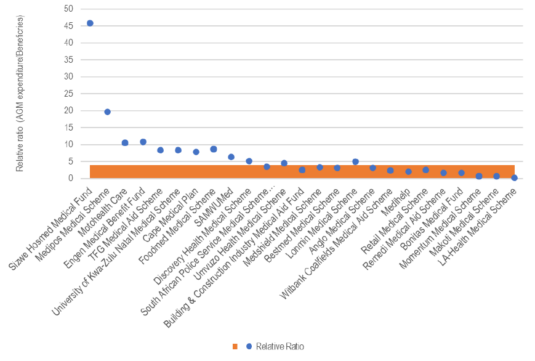Of the 71 registered medical schemes in South Africa, 33 incurred AGM-related expenses totalling R29.2 million in 2022.
In a media statement released last week, the Council for Medical Schemes (CMS) deemed this spending pattern “worrisome”, adding that the “extravagant” costs associated with AGMs necessitated an in-depth investigation into the potential factors contributing to this outlay.
In December last year, the CMS published the 2022 Medical Schemes Industry Report and Annexures.
Read: What medical schemes paid brokers in 2022
The CMS said that upon closer inspection of the annexures, the regulator noticed significant expenditure on AGMs hosted by medical schemes.
According to a new research report published by the CMS titled Annual General Meetings of Medical Schemes: Importance and Challenges Associated with Limited Member Participation, five medical schemes exhibited significantly higher spending than other schemes bearing a substantially higher proportion of the total AGM expenditure.
These schemes included Sizwe Hosmed Medical Fund, Medipos Medical Scheme, Engen Medical Benefit Fund, Motohealth Care and Foodmed Medical Scheme.
Other schemes with possible high AGM-related spending include University of Kwa-Zulu Natal Medical Scheme, TFG Medical Aid Scheme, Cape Medical Plan, SAMWUMed, Discovery Health Medical Scheme, the report found.
Why AGMs are important
In the regulatory environment, medical scheme members have the right to participate in their medical scheme’s governance through participation in scheme AGMs, Special General Meetings (SGMs) and Trustee elections.
At least 50% of the members of a scheme’s Board of Trustees (BoT) must be elected among the scheme members by members.
Medical schemes must hold AGMs consistent with scheme rules on having AGMs on or before a particular date. During these meetings, medical scheme members may voice opinions, ask questions and present motions.
Members have the right to information about their schemes, therefore, schemes must, on request, provide information about:
- Scheme rules and benefits;
- latest annual financial statements;
- management accounts and accompanying annual financial statements; and
- a list of protocols and formularies.
According to CMS, AGMs are an essential governance component in the medical schemes environment, presenting a chance for schemes principal officers, BoTs and administrator(s) to account for the management of the scheme to beneficiaries.
“This is an opportunity for medical scheme members to voice opinions, ask questions and present motions,” the CMS says.
Despite the inherent significance of AGMs, limited member participation is a major challenge for AGMs, impacting their effectiveness.
According to CMS, the report delved into AGM expenditures in 2022 to address issues like low participation and identify strategies to encourage attendance.
In addition to doing this, however, the research report shed light on trends and disparities within the medical scheme landscape.
Key statistics
While 33 of the 71 medical schemes forked out just under R30 million on AGM-related expenses in 2022, the other 38 didn’t spend a cent.
The ones with AGM expenses covered a total of 8.1 million lives, whereas those without spent covered 850 248 lives.
When you break it down per person, the ratio is 3. The researchers used this metric to compare AGM expenses across different schemes, irrespective of their size. The data gave a clear picture of how common AGM-related costs were in the medical scheme landscape, showing where these expenses happened and how they related to the number of lives covered by the schemes.
The data revealed a disparity in expenditure levels between open and closed schemes: expenditures in open schemes were nearly sixfold higher than those observed in closed schemes.
“The aggregate industry expenditure for AGMs amounted to R29.2 million in 2022, with a noteworthy predominance of open schemes contributing 85% to the total spending, while closed schemes constituted a comparatively smaller proportion, accounting for 15% of the overall industry spending,” the report read.
What’s more, schemes operating on an outsourced model incurred 90% of AGM-related expenditure, while those with an insourced or self-administered incurred 10% of the spending.
The report also found that larger schemes contributed a significantly higher proportion of the total expenditure.
“In 2022, mainly, large schemes constituted a substantial 96% of the overall spending, while medium and small schemes contributed modestly with 3% and 1%, respectively,” the report found.
Tracking expenditure relative to the number of lives covered, some schemes exhibited significantly higher spending than others (see Figure 1).

Figure 1: Identification of schemes with identified high AGM expenditure-2022
Source: Own construction from CMS (2023)
Sizwe Medical Fund had an extreme value with a relative ratio of 46. Medipos Medical Scheme followed with a relative ratio of 20, and Engen Medical Benefit Fund and Motohealth Care at 11.
The benchmark value was 4.
“In identifying these schemes, particularly the Sizwe Hosmed Medical Fund, further exploration is warranted into the potential factors contributing to their exceptionally high AGM fees. Understanding the reasons behind these outliers is crucial for gaining insights into these schemes’ financial dynamics and governance practices”, the report read.
A secondary list of schemes with relative ratios falling between five and 9 included the Foodmed Medical Scheme, the University of Kwa-Zulu Natal Medical Scheme, the TFG Medical Aid Scheme, the Cape Medical Plan, the SAMWUMed, and the Discovery Health Medical Scheme.
The report noted that “while not as extreme as the first set of schemes”, these entities also exhibited noteworthy relative ratios, “prompting consideration for further investigation into the drivers of their AGM-related expenditures”.
“Further explorations and assessment are needed on schemes that depicted a relative ratio exceeding 10 to understand the key drivers and attributes, which is a concerning observation,” the report read.
Challenges and strategies
The report found that limited awareness among members posed a key challenge to active participation in AGMs, as did the fact that many may not grasp the importance of these meetings. Geographic, logistical, and technological hurdles, such as distant locations or lack of virtual access, also impeded involvement. Additionally, some members perceived AGMs as irrelevant, lacking a clear link between participation and healthcare benefits.
According to the report, communication gaps further exacerbated the issue, as “ineffective” strategies left members uninformed about AGM purpose and outcomes.
What was needed, the report said, was an inclusive approach, enhancing communication, addressing accessibility barriers, and highlighting the concrete benefits of active AGM participation.
The report suggested these strategies to enhance member participation:
- Emphasising improved communication to establish precise and targeted strategies to convey the importance of AGMs, the topics to be discussed, and the impact of member participation on the decision-making process.
- Utilising diverse communication channels, such as emails, newsletters, and social media platforms to enhance outreach and to ensure that members are well-informed.
- Offer virtual participation options through video conferencing or live streaming to make AGMs more accessible, especially for members facing geographic or logistical challenges.
- Introduce incentives for participation, such as discounts on premiums or wellness programme perks.
- Invest in education and advocacy through campaigns highlighting the tangible benefits of active participation.
- Transform AGMs into interactive forums through Q&A sessions, polls, or surveys.
- Foster a sense of community through pre-AGM events.
- Establish feedback mechanisms, such as post-meeting surveys or suggestion boxes.
- Recognise the diversity of the member base and tailor communication to resonate with different demographics, enabling schemes to craft messages appealing to a broader audience, ensuring inclusivity and active participation.
Other suggestions included leveraging technology and digital channels more effectively by strategically implementing user-friendly online platforms and mobile apps to streamline the AGM registration and participation processes.
To accommodate busy schedules, flexible scheduling options were proposed.
To promote transparency, the report proposed simplifying documentation, presenting financial information clearly, and publishing detailed meeting minutes.
The read the complete research study, click here.



